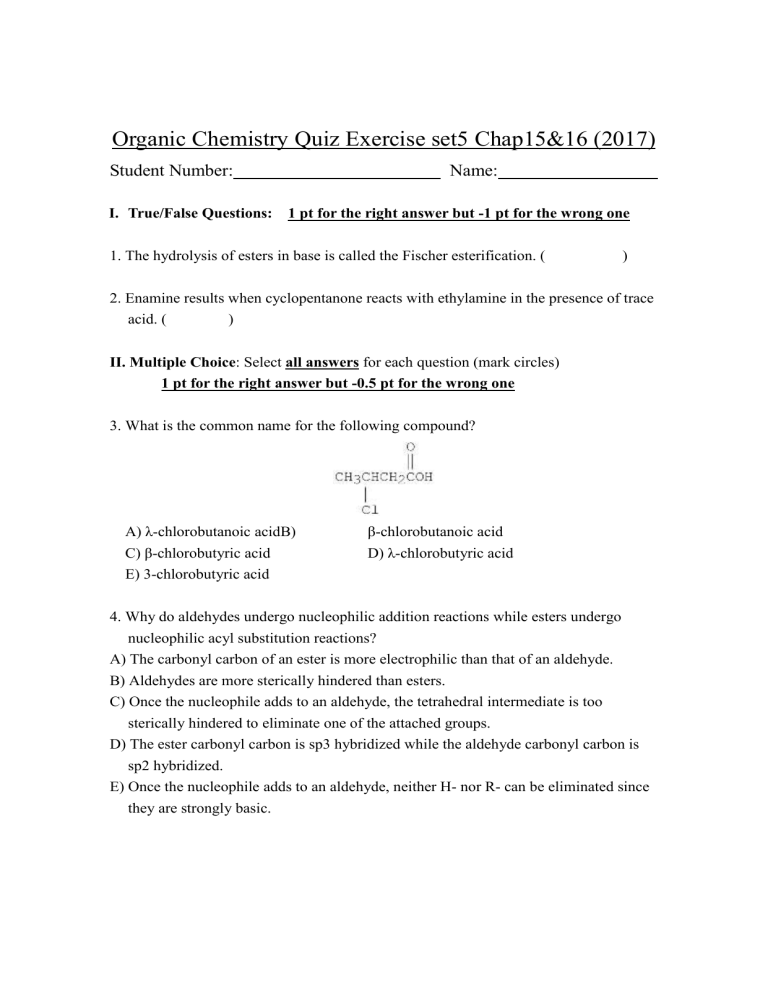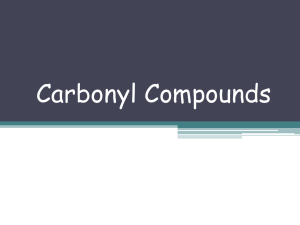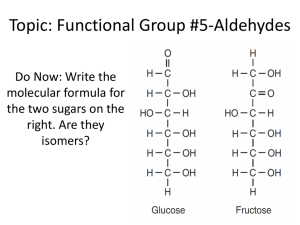Organic Chemistry Quiz exercise set5 (2017)
advertisement

Organic Chemistry Quiz Exercise set5 Chap15&16 (2017) Student Number: I. True/False Questions: Name: 1 pt for the right answer but -1 pt for the wrong one 1. The hydrolysis of esters in base is called the Fischer esterification. ( ) 2. Enamine results when cyclopentanone reacts with ethylamine in the presence of trace acid. ( ) II. Multiple Choice: Select all answers for each question (mark circles) 1 pt for the right answer but -0.5 pt for the wrong one 3. What is the common name for the following compound? A) λ-chlorobutanoic acidB) C) β-chlorobutyric acid E) 3-chlorobutyric acid β-chlorobutanoic acid D) λ-chlorobutyric acid 4. Why do aldehydes undergo nucleophilic addition reactions while esters undergo nucleophilic acyl substitution reactions? A) The carbonyl carbon of an ester is more electrophilic than that of an aldehyde. B) Aldehydes are more sterically hindered than esters. C) Once the nucleophile adds to an aldehyde, the tetrahedral intermediate is too sterically hindered to eliminate one of the attached groups. D) The ester carbonyl carbon is sp3 hybridized while the aldehyde carbonyl carbon is sp2 hybridized. E) Once the nucleophile adds to an aldehyde, neither H- nor R- can be eliminated since they are strongly basic. 5. Which of the sequences works best to accomplish the following conversion? A) 1. NaCN, HCl 2. H2, Pt C) 1. NaNH2 2. H3O+ E) 1. NH3, H+ 2. H2, Pt B) 1. H2NCH2MgBr 2. H3O+ D) 1. H2NNH2, H+ 2. H3O+ 6. Diisobutylaluminum hydride (DIBALH) can be used to carry out which of the following conversions? A) ester to aldehyde C) 2 alcohol to ketone E) ester to ketone B) carboxylic acid to ester D) aldehyde to carboxylic acid III. Short Descriptions (2 pts for each) 7. What is the common name for the following compound? _____________________________ 8. Which C—N bond below is shorter, I or II? Explain. ______________________________________________________ 9. List the following carboxylic acid derivatives in decreasing order of reactivity in nucleophilic. 10. What is/are the major product(s) of the following reaction? ______________________________





